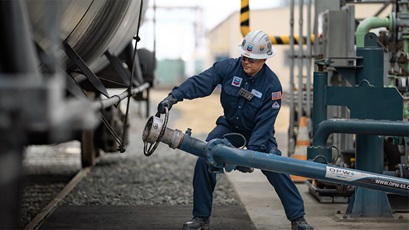our operations
chevron’s first-quarter results highlight operational, financial strength
3 min read | may 02, 2024 | may 02, 2024
The Tengiz supergiant oil field in Kazakhstan has celebrated multiple milestones over its 30-year journey, including its most recent expansion project.
Chevron reported another first quarter of strong operational and financial performance and superior returns for shareholders. The company delivered key milestones in Kazakhstan, reported record production levels and expanded investments to support a lower carbon future.
supergiant oil field reaches major milestone
Tengizchevroil (TCO) has started operations at its Wellhead Pressure Management Project (WPMP) at the Tengiz oil field in Kazakhstan. This milestone enables existing plants to operate at full capacity and marks important progress for the company’s overall expansion project in Tengiz.
A look back: Transforming Tengiz into a supergiant has been a 30-year journey.
Safety first: Workers and technology are focused on keeping the Tengiz facility running safely and reliably.
kevin lyon
Tengizchevroil general director
innovation fuels lower carbon, record production

Chevron aims to reach 1 million barrels of oil-equivalent per day in the Permian Basin by 2025.
Chevron’s overall production hit a record 3.1 million barrels of oil-equivalent per day in 2023. In the Permian Basin, an energy-producing powerhouse in West Texas and New Mexico, output was up 10% year-over-year.
Factory approach: Increased production was driven by disciplined execution and advances in drilling techniques.
Prolific Permian: Unique rock characteristics make the Permian Basin one of the most prolific fields in the world.
Reduction efforts: Collaboration within the energy sector is helping reduce methane emissions in regions like the Permian Basin.
$500 million fund to invest in lower carbon future
Chevron Technology Ventures (CTV) recently announced its $500 million Future Energy Fund III. The fund will support the evolving energy system by investing in companies that are developing lower carbon technologies.
Carbon capture, utilization and storage (CCUS): CCUS can help reduce the carbon intensity of industrial operations.
Hydrogen: As the most abundant element in the universe, hydrogen presents many opportunities for a lower carbon future.
Lower carbon intensity fuels: Renewable fuels, including biodiesel made from seed oils and animal byproducts, offer sources of alternative energy.
luis alcoser
future energy fund general manager
new facility to boost renewable fuels

Soybeans and other seeds will be processed into feedstocks for renewable fuels at a new plant in Destrehan, Louisiana.
Bunge, a global agribusiness, and Chevron announced a new oilseed processing plant in Louisiana to help meet rising demand for renewable fuel feedstocks.
Biofuel breakthroughs: The facility will process soybeans and softseeds like novel winter oilseed crops.
A viable option: Renewable fuels can help lower the carbon intensity of most cars and trucks on the road today.
Teamwork: Agricultural suppliers and energy companies can work together to keep waste from landfills, increase crop yields and help develop lower carbon intensity fuels.
chevron is targeting a production capacity of
100,000
barrels per day of renewable diesel, sustainable aviation fuel, biodiesel and other biofuels by 2030
hydrogen facility is a chevron first

Lost Hills is California’s largest net energy metering project and Chevron’s largest solar facility.
Lost Hills, one of Chevron’s long-standing facilities in California’s San Joaquin Valley, will start producing hydrogen in early 2026. It is the first Chevron-only commercial electrolytic hydrogen project.
Sun powered: Lost Hills will leverage energy from its 29-megawatt solar field to produce hydrogen.
A growing market: Demand for the lower carbon intensity fuel could reach 225 million tonnes per year by 2050.
Future of hydrogen: Chevron believes technology, partnership and policy will be key drivers for making faster progress toward scaled solutions.
lower carbon intensity hydrogen demand

Source: IEA, Announced Pledges Scenario, 2030–2050
topics covered
related content
-

 gas development opportunities in sub-saharan Africa
gas development opportunities in sub-saharan Africaour operationsdecember 20, 2024
-

 AI boosts profitability in the permian basin
AI boosts profitability in the permian basinour operationsdecember 18, 2024
-

 new california legislation misleading, chevron exec says
new california legislation misleading, chevron exec saysour operationsnovember 26, 2024
-

 the power of collaboration: teaming up with microsoft, slb
the power of collaboration: teaming up with microsoft, slbour operationsnovember 25, 2024
chevron email updates
Subscribe to our newsletter to receive news and updates.



